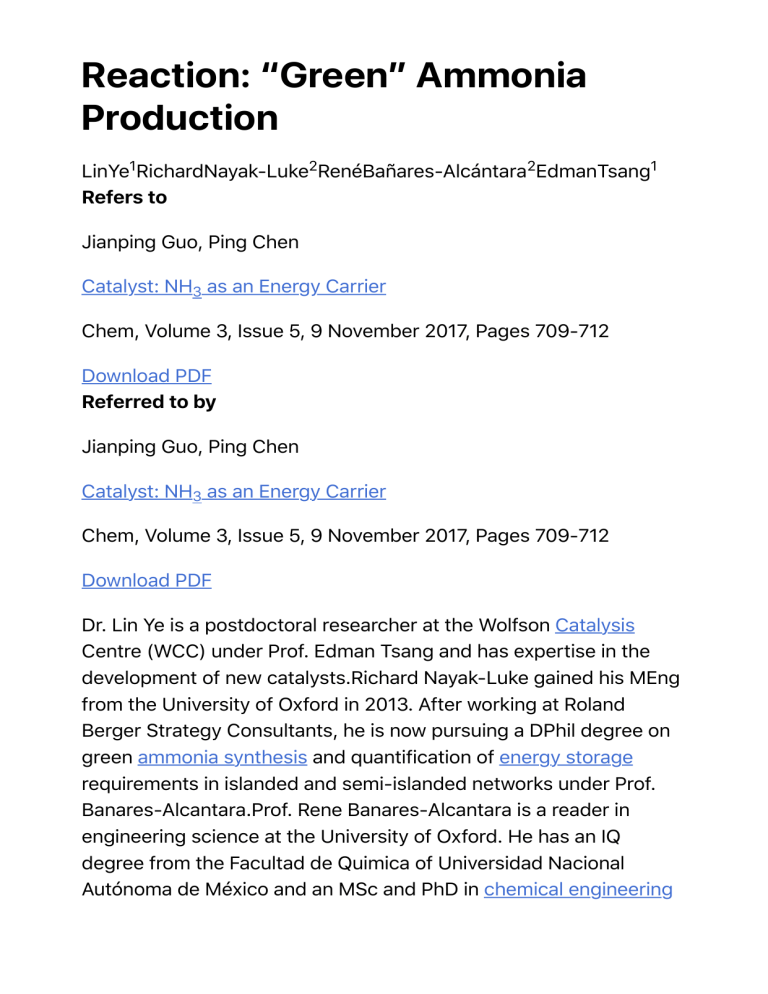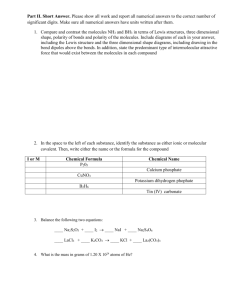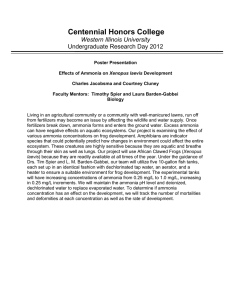Reaction- “Green” Ammonia Production - ScienceDirect 2019-09-19 11 26 57
advertisement

Reaction: “Green” Ammonia Production LinYe1RichardNayak-Luke2RenéBañares-Alcántara2EdmanTsang1 Refers to Jianping Guo, Ping Chen Catalyst: NH3 as an Energy Carrier Chem, Volume 3, Issue 5, 9 November 2017, Pages 709-712 Download PDF Referred to by Jianping Guo, Ping Chen Catalyst: NH3 as an Energy Carrier Chem, Volume 3, Issue 5, 9 November 2017, Pages 709-712 Download PDF Dr. Lin Ye is a postdoctoral researcher at the Wolfson Catalysis Centre (WCC) under Prof. Edman Tsang and has expertise in the development of new catalysts.Richard Nayak-Luke gained his MEng from the University of Oxford in 2013. After working at Roland Berger Strategy Consultants, he is now pursuing a DPhil degree on green ammonia synthesis and quantification of energy storage requirements in islanded and semi-islanded networks under Prof. Banares-Alcantara.Prof. Rene Banares-Alcantara is a reader in engineering science at the University of Oxford. He has an IQ degree from the Facultad de Quimica of Universidad Nacional Autónoma de México and an MSc and PhD in chemical engineering from Carnegie Mellon University. His research interests include process systems engineering.Prof. Edman Tsang is a professor of chemistry at the University of Oxford and director of the WCC. His research interests are novel inorganic materials, green energy and chemical provisions, and catalysis. Previous article Next article Main Text Green Ammonia Production Ammonia production currently accounts for over 1.8% of the world’s consumption of fossil fuels and consequently over 1% of carbon dioxide emissions (C. Philibert, 2017, NH3 Event, conference). The current production of ∼180 MT/year is predicted to increase to ∼270 MT/year by 2050 (C. Philibert, 2017, NH3 Event, conference), understandable given that over 80% of all ammonia produced is used for fertilizers. These predictions, combined with the requirement of net-zero carbon dioxide emissions for the 2°C scenario,1 mean that there is an environmental imperative to decarbonize industrial ammonia production methods. Currently, steam methane reforming or (to a lesser extent) coal gasification is used to provide the hydrogen component of the syngas. Three possible methods are currently being considered for decarbonization: (1) conventional production with sequestration of the carbon dioxide, (2) hydrogen production via water electrification using renewable energies (wind, solar, and tidal wave, etc.) in a modified small-scale Haber-Bosch (HB) process (eHB), and (3) development of alternative methods of production (i.e., electrochemical). Although designing new ammonia plants with integrated carbon capture and storage (CCS) or retrofitting CCS to conventional plants does have notable potential, here we will focus on the latter two production methods mentioned above. The rationale for this is that, despite the fact that this method could play a part in production in the future, its cost could be uncompetitive as a result of the dramatic falling cost of renewable energy (RE). Water Electrification Using Renewable Energies in the eHB Process The use of hydrogen gas from electrification (water electrolysis using renewable energies) in the eHB process for ammonia production contrasts with conventional large-scale HB processes utilizing natural gas or coal gasification because the former process gives zero carbon emission. However, coupling an adequate supply of dihydrogen from electrolysis with nitrogen could be challenging for maintaining high ammonia productivity. Generally, hydrogen pressure generated from water electrolysis is relatively low (<20 bar). The unfavorable kinetics at low pressure, combined with the strong thermodynamic barrier (94.1 kJ/mol) that the nitrogen triplebond dissociation poses, could limit the ammonia production rate. In the traditional industrial process, production volume and cost are highly dependent on natural gas availability. However, reducing the dynamic supply of H2 for the new anticipated low-pressure electrification process is likely to decentralize traditionally large integrated HB installations into small-scale islanded eHB units. The new process also requires a new catalyst to show significant catalytic activity at lower pressure to save the cost of investment and mitigate the safety risks. It is thus of great significance to dwindle the reaction pressure to reduce operational cost and energy requirements and achieve the eHB process. Compared with commercial Fe, Ru is a potential candidate for the eHB process because it is relatively active at low pressure. Ru with a higher electron density of d orbitals can donate electrons into the anti-bonding orbital of adsorbed N2, facilitating its dissociation, and hence can work under lower pressure. However, Ru-based catalysts have found limited uses in conventional HB processes because they are relatively more expensive and are easily poisoned by carbon deposition from CH4 decomposition in syngas. The eHB system, where H2 is derived from water, does not contain CH4, so the poisoning effect can be well avoided, making Ru a potential candidate for low-pressure synthesis. Given its high cost, it is also necessary to improve the activity of Ru-based catalysts for better operation of the eHB process. Cs–Ru-based catalysts are currently used in the low-pressure Kellogg Advanced Ammonia Process.2 Recently, some new promising Ru-based systems3, 4 have attracted great attention. Direct Electrochemical Ammonia Production However, the high cost of H2O electrolysis, coupled with the often low price of natural gas, makes this eHB approach currently economically less attractive than conventional HB synthesis. Electrochemical synthesis, in contrast, permits the direct reaction of N2 with H2O to form NH3 at ambient pressure. In principle, the reaction can proceed under such conditions, as seen in biology. The challenge is to reduce the highly inert N2 molecule in the presence of the more easily reduced species, H2O, at industrially useful rates. Many cells have been proposed for carrying out the direct electrochemical NH3 synthesis.5 However, according to the targets for feasible industrial installations imposed by the US Department of Energy (DOE) REFUEL program (current density > 300 mA cm 2 and current efficiency > 90%, which is equivalent to an effective rate of 9.3 × 10−7 mol cm−2 s−1), the vast majority of reports fall on or below 10−8 mol cm−2 s−1. This corresponds to a current density of around 3 mA cm 2 at 100% current efficiency, which is far short of the DOE target of 300 mA cm 2 at >90% current efficiency. This value could reflect the use of relatively low-surface-area electrodes rather than the nanoparticle catalysts found in electrolyzers. This highlights the challenge of not just activating N2 to make NH3 but also doing so selectively in the presence of more easily reduced species, such as H2O. Recently, Ito et al. reported a novel hybrid cell to alleviate the problem.6 They achieved this by combining molten eutectics by separating N2 reduction in LiCl/KCl from water splitting in NaOH/KOH with a bipolar Pd membrane. This allowed H to be supplied from water without a spontaneous reaction with N3−, thus preventing an increase in the required cell voltage. In both hydroxide and chloride electrolytes, there was evidence that varying the catalyst material could enhance the rates. Overall, some approaches are promising, particularly those using molten eutectics with rates and/or current efficiencies approaching the DOE targets. This success has led to an increasing amount of research over the last couple of years, and more developments can be expected. Techno-economic Evaluations Previous investigations into the electrification of hydrogen production have resulted in a range of levelized cost of ammonia (LCOA) estimates depending on their mode of operation. These investigations can be separated into three groups defined by their energy supply: (1) solely grid supply (e.g., 713–1,178 USD/T and 520 EUR/T using wholesale market electricity); (2) semi-islanded operation, i.e., supported by either the grid or another dispatchable source (e.g., 580–1,124 and 680–2,300 GBP/T using grid supply and biomass in semi-islanded operation); or (3) islanded operation, i.e., using a “buffer” to maintain system stability (e.g., 665 GBP/T7 using ammonia). As outlined by Cédric Philibert at the International Energy Agency, “ammonia production in large-scale plants based on electrolysis of water can compete with ammonia production based on natural gas, in areas with world-best combined solar and wind resources.”8 The use of renewable power sources to electrify the production process in islanded operation brings its own problems. The intermittency of the power supply (specific to the location of interest) requires careful consideration during planning of the plant design and its subsequent operation. If this is not taken into account, undesirable disruptions in the synthesis loop are likely to occur,8 which would increase operational cost and the predicted LCOA. We have recently identified that five key variables have a significant impact on the estimated LCOA for islanded production. Aside from the location, two cost and three process variables were found to have the most impact (calculated in relation to a ±10 GBP/T change in LCOA): levelized cost of electricity (±0.89 GBP/MWh), electrolyzer capital expenditure (±65 GBP/kW), minimum HB process load (±12% of rated power), maximum rate of HB process load ramping, and RE supply mix. Although the production of “green” ammonia as a commodity will be economically viable long before it will be viable as an energy vector (unless there are significant incentives for long-term energy storage services), it appears to have significant potential for seasonal electricity storage. As the penetration of intermittent renewable power sources increases, so does the requirement for network flexibility to facilitate their integration. Multiple methods (such as demand-side management, curtailment, and energy storage) can provide this flexibility, but realistically a combination of all of them will be most economical for most networks at high RE penetration. Pumped hydroelectricity is widely considered to be the goldstandard and clearly dominant electrical energy storage method employed to date. This, however, ignores the fact that the majority of networks still store virtually all of their energy as unburnt fossil fuel stocks. Take the 2016 storage capacities in the UK for example: 0.0234 GWh for batteries (lithium ion, lead acid, and lithium phosphate), 27.6 GWh for pumped hydroelectricity, 29,900 GWh for coal, and 47,100 GWh for natural gas. Although simply looking at the energy capacity of stored energy is certainly not the whole picture (an appreciation of dispatchable power and an understanding of the network balancing methods are essential), this does highlight our current dependence on fossil fuels. The increasing RE penetration is therefore a compounding problem: it increases the need for network flexibility while cutting the existing network flexibility on the basis of fossil fuel stocks (which we depend on for medium to seasonal balancing). The impact of this has been seen in multiple networks around the world (e.g., UK and Germany) such that an increased need for frequency stabilization and a fall in storage costs have led to significant integration of battery storage (predominantly lithium ion). With ever-increasing renewable penetration, even with careful selection of RE supply, more and longer-term electrical storage is likely to be needed (see Figure 1). Figure 1. Energy Storage Technologies Modified with permission from N. Olson (2017, NH3 Event, conference), originally adapted from Hydrogenious Technologies. Although hydrogen has significant potential for filling this storage gap, enthusiasm has unquestionably decreased from the “hydrogen economy” heights. Two of the main reasons for this are the infrastructure required for its implementation and the technical requirements for storage. “Chemical storage” of hydrogen has been of particular interest in recent years. Ammonia has significant potential because of its favorable chemical and technical characteristics. Let’s not avoid the obvious: ammonia, unlike many other options such methane and methanol, is carbon free. It has a good energy density (lower heating value of 18.6 MJ/kg), can be easily stored (boiling point of −33°C at 1 atm), is stable (can be stored without notable energy loss), and is relatively safe (i.e., nonexplosive and easily detectable). Ammonia is already produced in large quantities, and therefore there is already significant infrastructure for its manufacture, transportation, and storage. However, if it is also to be used as a “green” energy storage vector, this production would have to significantly increase; if all current ammonia production were converted to electricity (if we assume 50% conversion efficiency), it could independently meet average global electricity demand for ∼7 days. In conclusion, the development of “green” ammonia production methods is an environmental imperative as one of the measures for reaching net-zero carbon dioxide emissions. The promising new ammonia production methods outlined above can work well under mild conditions. As the cost of RE rapidly decreases, ammonia holds great potential (given its favorable technical and chemical characteristics) at least as a partial substitute for fossil fuels as a seasonal electrical storage method. This offers exciting potential for using ammonia to store energy with better energy density factors than liquid hydrogen. An established logistics chain for worldwide trading and transportation of ammonia already exists. Compressed ammonia is a current solution for ammonia storage and transportation, but for longer-term applications (given that ammonia is toxic and corrosive), new storage and transport systems for decarbonized commodities and energy vectors should be continually developed. References R. Millar, M. Allen, J. Rogelj, P. Friedlingstein Oxf. Rev. Econ. Policy, 32 (2016), pp. 323-342 K. Aika, T. Takano, S. Murata J. Catal., 136 (1992), pp. 126-140 M. Kitano, Y. Inoue, Y. Yamazaki, F. Hayashi, S. Kanbara, S. Matsuishi, T. Yokoyama, S.W. Kim, M. Hara, H. Hosono Nat. Chem., 4 (2012), pp. 934-940 K. Sato, K. Imamura, Y. Kawano, S.I. Miyahara, T. Yamamoto, S. Matsumura, K. Nagaoka Chem. Sci. (Camb.), 8 (2017), pp. 674-679 V. Kyriakou, I. Garagounis, E. Vasileiou, A. Vourros, M. Stoukides Catal. Today, 286 (2017), pp. 2-13 Y. Ito, T. Nishikiori, H. Tsujimura Faraday Discuss., 190 (2016), pp. 307-326 R. Bañares-Alcántara, G. Dericks III, M. Fiaschetti, P. Grünewald, J. Masa Lopez, E. Tsang, A. Yang, L. Ye, S. ZhaoAnalysis of islanded ammonia-based energy storage systems University of Oxford (2015) http://www.eng.ox.ac.uk/systemseng/publications/Ammoniabased_ESS.pdf C. PhilibertProducing ammonia and fertilizers: new opportunities from renewables International Energy Agency (2017) https://www.iea.org/media/news/2017/FertilizermanufacturingR enewables_1605.pdf View Abstract © 2017 Elsevier Inc.






